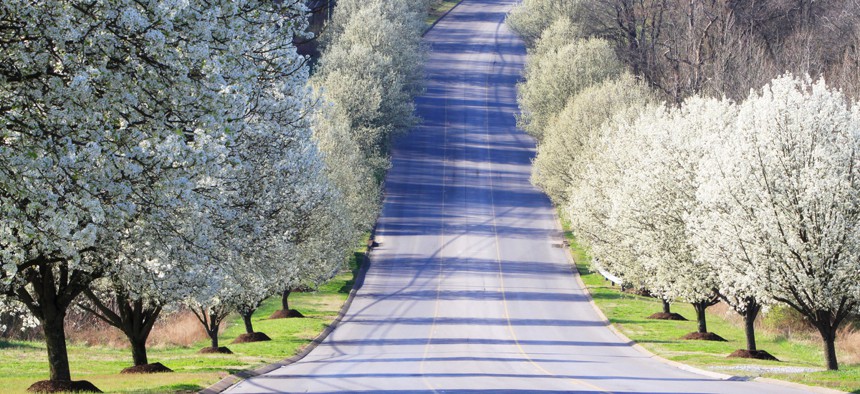The Detested Bradford Pear Tree Is Coming to a Forest Near You

The Bradford pear tree is often called a "weed." KennStilger47/Shutterstock

Connecting state and local government leaders
Cities and states are trying to remove Bradford pears‚ but the “weed trees” have already intruded deep into some forests, a biologist warns.
In the 1960s, America fell in love with a new tree: the Bradford pear. Cultivated from Asian stock by scientists at the U.S. Department of Agriculture, Bradford pears display clouds of pretty blossoms in the spring and garnet leaves in the fall, and are hardy enough to grow just about anywhere. Thinking they had found the perfect ornamental tree, homeowners and public-works departments planted Bradford pears up and down the nation’s streets for decades, especially in the East, South, and Midwest.
Then the relationship soured. Bradfords are apt to split and break during storms, and they have a short life span, only 15 or 20 years. Although they are technically sterile, the trees cross-pollinate with other cultivars of the Callery pear species (Pyrus calleryana), producing fruit that splats all over sidewalks. And despite their delicate appearance, the blossoms emit a foul odor that’s been compared to rotting fish (among other things).
Once admired for its hardiness, the Bradford pear is now considered an invasive species, which grows even in poor conditions, proliferates fast—thanks to birds that dine on its fruit and spread the seeds—and crowds out native species.
Cities are trying to put an end to the tree’s mischief. Pittsburgh’s Urban Forest Master Plan prohibits planting Bradford pears. This March, Fayetteville, Arkansas, started offering a bounty to anyone who cuts one down. (They can get a free native tree to replace it.)
The bad news is it’s not only in developed areas where the trees threaten to choke biodiversity. Theresa Culley, head of the Department of Biological Sciences at the University of Cincinnati, warns that wild Bradfords and other kinds of Callery pears are making inroads into Eastern forests.
“Previously, we always noticed the pears along the roadsides, and at the outer parts of forest, near the edges,” Culley told CityLab. “We’ve always thought that’s because European starlings, which [eat the fruit], like to perch on the electrical lines along the road. [So] that’s where the pears are.”
She continued: “A few years ago, I was giving a talk, and someone came up to me and said, ‘I’ve been seeing them in a forest.’ I thought, ‘That doesn’t make sense at all.’ Then I started looking around.” Culley has seen wild Callery pears in forests in Ohio and Indiana, and is hearing reports of them in Illinois, too.
With her colleague Tziporah Serota, Culley recently studied seed germination and survival in Callerys. Among seeds that had been kept in cold storage for 11 years, many were still able to germinate, and seedlings had a “moderate to high” survival rate.
“Seed longevity likely contributes to the invasive tendencies of Callery pear, enabling it to persist in disturbed sites and natural areas, resulting in the proliferation of trees despite efforts at surface-level removal,” Culley and Serota wrote in the botany journal Castanea.
As for why the pear trees are encroaching past forest edges, Culley has a hunch. European starlings feed on the trees’ fruit, but so do American robins, which are more solitary and behave differently from starlings. “They pick up a fruit and then fly to the interior of a forest and eat it, and then fly back out,” she said. “The idea is that maybe the pears are changing their behavior—the way they spread—because of the birds.” (Culley added that there is no research to back up this theory just yet.)
The emerald ash borer has also smoothed the path into the forest for wild Callerys. That infestation left behind many standing dead ash trees, and that, Culley said, means “light gaps, which pears like.”
Last year, the state of Ohio banned the sale or distribution of Callery pears, effective in 2023. The Indiana Natural Resources Commission has suggested it will add Pyrus calleryana to its list of banned invasive species in the future. In South Carolina, state foresters are asking property owners to remove Bradford pears. “We are saying cut them down when possible,’’ a forestry commission spokesperson told The State in March. “It is just generally a nuisance tree.’’
But deep taproots make the trees hard to eradicate, and rising temperatures are only furthering their reach. Previously, the pears’ intolerance of cold stopped them from moving very far north in the United States. Now climate change is causing growing zones to shift.
“The Callery pear never used to be in Wisconsin. In recent years, we’ve seen it spreading within Madison,” Culley said. “It’s been having a little trouble getting outside of Madison—at least that’s what I’ve heard. But we’re expecting it will slowly start to spread out from there.”
Amanda Kolson Hurley is a senior editor at CityLab.

NEXT STORY: Exchange Programs Think Beyond Urban vs. Rural




